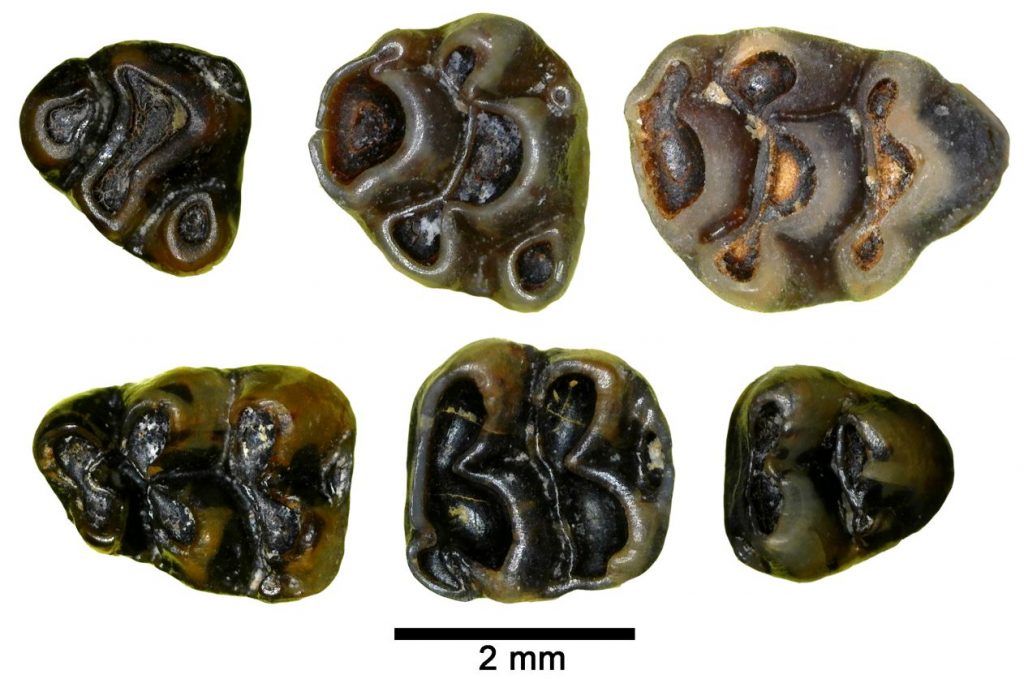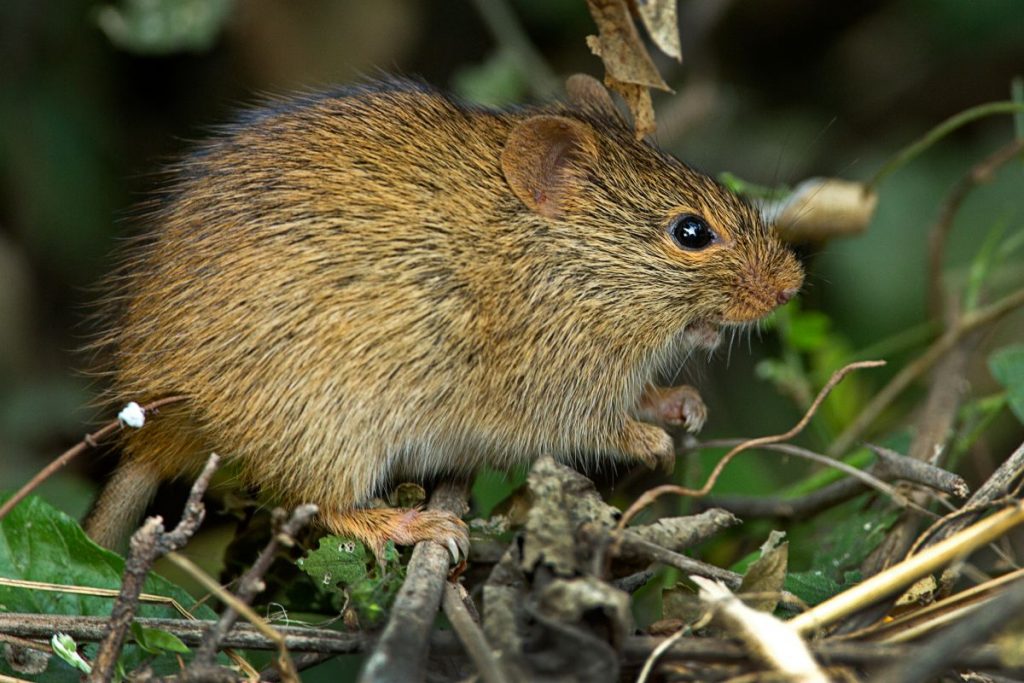Press notes 08/07/2020
An extinct species of large rodent newly discovered in Morocco
It lived around 2.6 million years ago and was significantly larger than the extant members of the genus Golunda

It lived around 2.6 million years ago and was significantly larger than the extant members of the genus Golunda
The American review Journal of Vertebrate Paleontology has recently published the first description of a newly discovered extinct species of large murid rodent (Old World mice and rats) found at the site of Guefaït-4, in the Jerada province, north-eastern Morocco. The finding was made by researchers from the IPHES and the University Rovira i Virgili (URV) in collaboration with specialists from the Mohammed 1st University of Oujda. The new species was named Golunda aouraghei in honor of Prof. Hassan Aouraghe from the Moroccan university, for his work in the Aïn Beni Mattar Basin and the Quaternary of Morocco.
Golunda aouraghei lived around 2.6 million years ago and is considerably larger than the extant representatives of the genus. “The body mass of the new species is estimated at 150-170 g, in contrast to the 60 g of the extant Golunda ellioti or the 25 g of the wood mouse (Apodemus sylvaticus)”, Pedro Piñero has argued, a researcher from the IPHES and the Faculty of Natural Sciences and Museum of La Plata National University (CONICET, Argentina).
Currently, the Indian bush rat (Golunda ellioti) is the only extant member of the genus, and its geographic range is restricted to Asia (Iran, India, western Pakistan, Nepal, and Sri Lanka). However, this murid also inhabited the African continent during the Pliocene (between 5.3 and 2.6 million years ago), with identified fossil remains in Ethiopia, Algeria and Morocco. “It is thought that this genus was originated in northern India, and that during the Pliocene it succeeded to reach Africa by crossing the two ends of the Red Sea (Sinai Peninsula and the Mandeb Strait), so it was able to settle in both North and East Africa” Pedro Piñero said.
Fossil rodents can provide valuable data in paleontological studies, since, thanks to the analysis of their dental morphology, on the one hand, they can be used as indicators of the age of the sediments where they are found, and on the other, they can help infer the environmental and climatic conditions that prevailed in a given place. Thus, the importance of this newly discovered species lies in the fact that it represents the last member of the genus Golunda in the African continent, which is highly relevant to the biochronology of North Africa. “Its dental morphology, for example, reflects adaptations to a more abrasive diet than that of its ancestor, due to the increase in aridity at the end of the Pliocene and the beginning of the Pleistocene in North Africa”, the researcher points out.

Many extinct rodents are defined based on their teeth, as these are the most frequently preserved skeletal elements and those that provides the most information at a species level. At the same time, dental morphology records perfectly the changes throughout the evolution of lineages, which may be related to adaptations to changes in climatic and environmental conditions. In this case, the teeth of Golunda aouraghei reflected adaptations to more arid climatic conditions than those of its ancestor, which originated in Algeria. Its dental elements showed an increase in the connections between the tubercles and an increase in the chewing surface, which is associated with an adaptation to a more fibrous diet, such as the herbaceous one.
Grassland expansion in detriment of forest relates directly to a decrease in humidity. In fact, glacial periods during the Pleistocene led to an increase in aridity that triggered the spread of open areas in North Africa, rather than a decrease in temperature in this region. Although Golunda aouraghei underwent some morphological changes as an adaptation to more open vegetation, the genus did not manage to survive the environmental changes in Africa. “Along with this rodent, others species adapted to more favorable conditions did not resist the strong climatic changes that occurred during the earliest Pleistocene and consequently became extinct in Africa”, Pedro Piñero commented.
Furthermore, the genus Golunda was thought to have disappeared from the African continent almost half a million years earlier, during the Late Pliocene. Golunda aouraghei thus becomes the last representative of this genus in Africa, extending its chronological range in this continent up to the Pliocene-Pleistocene boundary (at about 2.6 million years ago).

The fossil remains of the novel species were recovered from sediment collected during fieldwork at Guefaït-4 (Eastern Morocco), a site that has yielded a large number of fossils, both large and small vertebrates.
The finding is part of the research project “Evolution of the human peopling during the Quaternary in Eastern Morocco: Aïn Beni Mathar – Guefaït (Jerada Province)”. This project is the result of fifteen years of cooperation between the IPHES and the Faculty of Sciences (Department of Geology) of the Mohammed 1st University of Oujda, involving 14 Spanish and Moroccan researchers, from several institutions. During the development of the project, systematic geo-archaeological surveys have been carried out in the basin, resulting in the recording of an exceptional archaeological-paleontological heritage.
So far, this project has made it possible to locate and identify more than 30 sites that present a large number of archaeological remains documenting the human settlement throughout the whole Quaternary, from the Early Pleistocene through Holocene. “Thanks to those results, we reconstruct the evolution of human settlers in the region during Quaternary: their subsistence behaviors, the landscape and the available resources. This is main objective of the project”, as pointed out by M. Gema Chacón, researcher at IPHES, associate professor at the URV and associate researcher at the National Museum of Natural History in Paris.
Guefaït 4 is one of the main paleontological sites of this project. After three years of work, more than 4,000 faunal remains were recovered, allowing to the identification of more than 20 macro and microvertebrate taxa. The former group includes elephants, rhinoceroses, hippopotami, as well as a primitive species of the three-toed horse, Hipparion.
This mammal community also includes a significant number of rodents and reptiles, among which a giant tortoise, that places the site at the beginning of the Quaternary in a lake environment surrounded by a savannah. Rats and mice dominate the small-vertebrate association, with up to four different species including the new Golunda species described in this work. Remains of terrestrial squirrels, gundis, gerbils, dormice, shrews, glass lizards, colubrids, poisonous snakes and painted frogs have also been found. So far, no evidence of human occupation was reported at Guefaït-4.
The project is funded by the Palarq Foundation, the Spanish Ministry of Culture and Sport (ref.: 42-T002018N0000042853 and 170-T002019N0000038589), the Direction for Cultural Heritage (Ministry of Culture and Communication, Morocco), the Faculty of Sciences (Mohammed 1st University of Oujda, Morocco), INSAP (Institut National des Sciences de l’Archéologie et du Patrimoine), the Spanish Ministry of Science, Innovation and Universities (ref.: CGL2016-80975-P, CGL2016-80000-P, PGC2018-095489-B-I00, and PGC2018-093925-B-C31), and Research Groups Support of the Catalonia Government (2017 SGR 836 and 2017 SGR 859).
A few days ago, another scientific contribution in the frame of the same project was also published in Journal of Maps: the first detailed map of the High Plateaus Basin (Intra-Atlas Maghrebian depression) in Morocco thanks to the use of drones that have made it possible to take high-resolution aerial and topographic images. The research has involved members of IPHES and URV and is led by Alfonso Benito, a researcher at the CENIEH (National Research Centre on Human Evolution).
References:
Piñero, P., Agustí, J., Haddoumi, H., El Hammouti, K., Chacón, M.G., Sala-Ramos, R. (2020). Golunda aouraghei nov. sp., the last representative of the genus Golunda in Africa. Journal of Vertebrate Paleontology.
Benito-Calvo, A., Haddoumi, H., Aouraghe, H., Oujaa, A., Chacón, M.G., Sala-Ramos, R. (2020). Geomorphological analysis using small unmanned aerial vehicles and submeter GNSS (Gara Soultana butte, High Plateaus Basin, Eastern Morocco). Journal of Maps.
